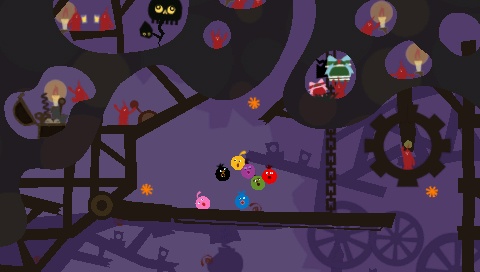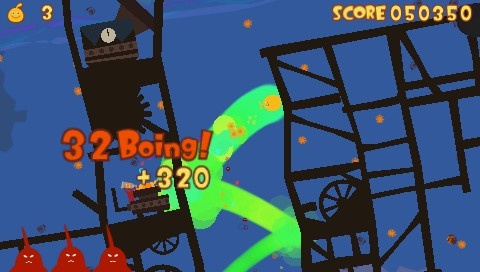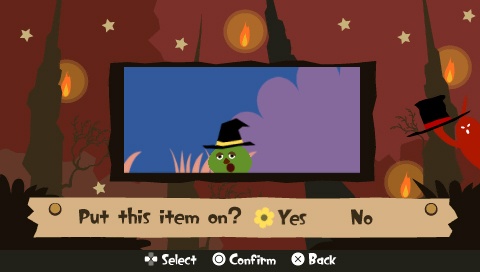Since bursting out of the rainbow, kitten, and smile factory, the LocoRoco series has kept its identity firmly rooted in cute, family-friendly fun. This has included a simple-but-charming art style, world-rotating gameplay, and an infectious soundtrack. But while this latest instalment keeps the foundation of the series intact, new gameplay mechanics, darker themes, and tougher difficulty make LocoRoco: Midnight Carnival much less accessible.

Regardless of whether you're a rolling veteran or a first-time LocoRoco toe-dipper, the basics are simple: Use the PlayStation Portable's shoulder buttons to tilt the world left or right, steering your amorphous blob toward the finish line and avoiding environmental hazards. Along the way, you collect objects that help increase your score, aid your survivability, and serve as currency to purchase rewards from the in-game store. The next level is unlocked by completing the one preceding it.
Like in previous LocoRoco games, tapping the L and R buttons simultaneously causes your character to jump. But for the first time, you're now able to perform a series of bounces to improve your speed and the heights you can reach. Starting a new jump as you hit the ground initiates the new "Boing!" system, making your next jump higher and awarding a score bonus that increases the length of time you're able to maintain the rhythm. Used to bounce off walls or onto ledges in the environment, boing can grant access to hidden and otherwise inaccessible areas filled with bonus items, as well as act as a temporary speed boost as you travel through narrow channels throughout the levels. The timing window to trigger your next bounce is generous, while the mechanic adds a strategic element by forcing you to bet on the accuracy of your landing, as well as the fastest path to complete the level.
In addition to providing extra points, a successful run of boing includes visual and aural rewards with vibrant-coloured trails following your character, as well as instrumental flourishes in the music. These extra touches don't impact gameplay, and you're never required to keep time, but you'll return to the level's slightly more subdued ambient theme if you misjudge a bounce or take damage from an enemy. LocoRoco's soundtrack retains its cutesy charisma and is as catchy the hundredth time as it is on the first listen.

Early in the game, zones are made up of gentle rolling hills and tunnels. But as you progress through the 16 levels that make up the single-player campaign, you'll be transported out of snow- or jungle-themed settings and into thematically darker locales. These have heavier colour palettes, tougher platforming challenges, boss battles, and valleys of spikes to negotiate at speed with little margin for error. The difficulty curve is sharp, and because there aren't very many levels, it transitions from cruising to challenging in the blink of an eye.
Honing your world-tilting accuracy to stick landings on small platforms or avoid traps placed by the game's evil forces, the BuiBui, becomes crucial, but you shouldn't ever be left wondering which way to go or what it is you need to do next. Backtracking to explore often becomes impossible because of the game's level design, but while it may be a frustration initially, the short length of the levels encourages replay to find hidden objects and optimal speed paths. The challenges don't ever feel cheap or artificially inflated to hamper your progress, but while objectives may be easy to identify, getting to them is often tougher than it looks. It's not uncommon to fail a single element of a level several times over, such as mistiming a jump, overshooting a gap, or jumping early to keep your boing ticking. Most levels clock in between two and three minutes in length, while longer levels run to about the five-minute mark. Longer levels often include halfway save points, which allow you to continue to try a section at a cost. Having another go from the marker will cost you some of your collected pickories--the small flies you collect that act as the game's currency. Continuing repeatedly from a halfway marker without success bumps the cost of retrying with every unsuccessful go and begins to cut into your pickories purse quite quickly.
Restocking your supply of pickories is as easy as taking part in one of Midnight Carnival's two skill-tester-style minigames: a UFO catcher, where you control a metal claw and catch LocoRocos; or a pinball game, where you shoot LocoRocos into goals. Bonus stages are rewarded sporadically during the single-player campaign, so you should never be too poor to purchase continues. Pickories can also be spent to unlock antidamage charms and vanity clothing items from the in-game store. Putting a sombrero on your LocoRoco makes it look a little more personalised, but it won't help you perform any better.

Midnight Carnival breaks new ground for the series by allowing up to four players to race against each other in ad hoc multiplayer mode. It's one of the more poorly fleshed out components of the game. The clunky matchmaking process requires all players to select the same level (you won't be able to play levels you haven't already unlocked in single-player), while one nominated player hosts and the others attempt to join. Once in the game, you'll be able to see other players and interact by bouncing against them, but there are no shared collectible resources, which means you'll collect only what appears on your screen. Worse still, once all players have completed the level, there are no details indicating who has won, and the lack of any kind of lobby means you'll need to reconnect each time you want a game. There's no infrastructure play here, but a nifty online scoreboard allows you to track and compare your scores and times per level, while the top five players can upload videos showing their best runs, which aspiring LocoRacers can download for tips. You won't be able to view replays ahead of your progress in the single-player game, but it can provide some helpful guides for how best to deal with a level if you're stuck.
While ultimately the new boing gameplay, local multiplayer, and competitive online leaderboards will appeal to those with a penchant for speed runs and full clears, at $14.99 (A$23.95) LocoRoco: Midnight Carnival isn't as feature-rich as its more robust series counterparts, LocoRoco and LocoRoco 2. If exploring zones or crafting and executing the perfect run is up your alley, then the handful of levels here will suit you to a tee. However, if you come expecting the same gentle, cathartic blob rolling that popularised the series, you may find yourself frustrated by Midnight Carnival's more complex gameplay.